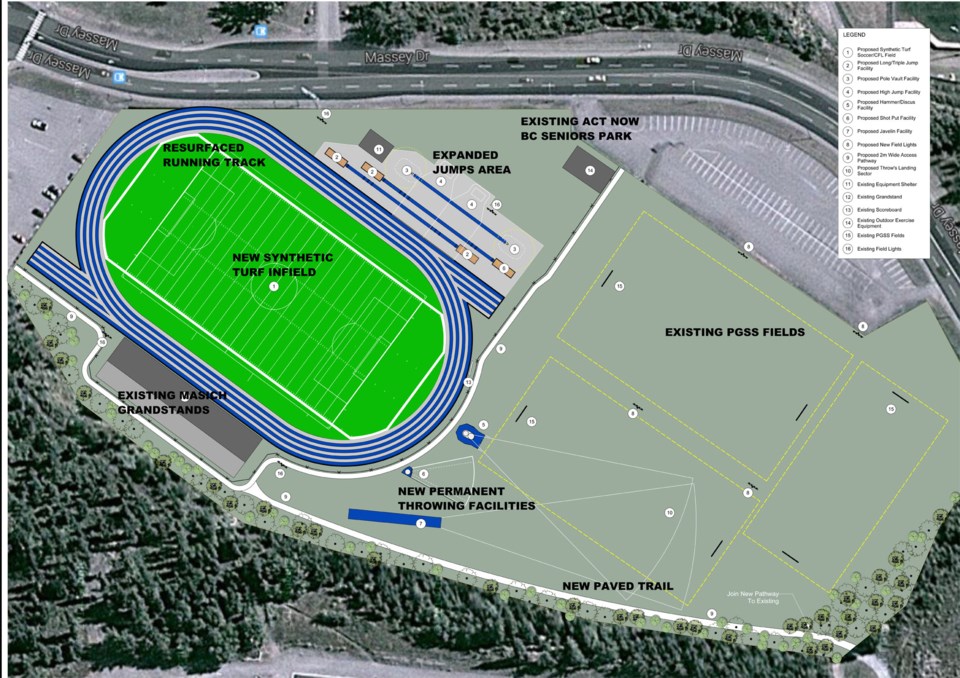The City of Prince George will unveil its final layout plan on Tuesday evening for its project to update Masich Place Stadium.
The public is invited to attend the meeting from 5:30 to 8:30 p.m. at the 25-year-old stadium to discuss the project with the architect (Doug Wournell of Dialog Design), designers and city staff.
Construction to install an all-weather synthetic turf field is slated to begin next spring.
The stadium is currently used by the Prince George Track and Field Club, B.C. High School Football Association and Prince George Minor Football Association and hosts annual events like the Relay For Life cancer fundraiser. When it is complete, the stadium will become the home of UNBC's male and female soccer teams for their Canadian Interuniversity Sport league games. It will also provide a facility for rugby and field lacrosse.
The city received close to 30 letters from user groups requesting installation of the all-weather field and replacement of the rubber 400-metre running track, which has outlived its life-span. The field surface will meet standards approved by Fédération Internationale de Football Association (FIFA), the Canadian Football League and World Rugby.
The four-month project will result in removal of the tree-topped grass berm which envelops the southern and eastern perimeters of the stadium. The jumps facilities and the throwing cages and fields used for track and field events will be consolidated in an area close to the south parking lot, which the city says will provide better viewing sight lines for spectators. The initial conceptual design was changed after public consultation and discussions with local and regional user groups.
"It will be a big improvement over what we've got now – we're going to have a beautiful facility, one that works," said Brian Martinson, president of the 170-member Prince George Track and Field Club.
"The one we have now doesn't work very well. It's 25 years old and it's difficult to try to put on a meet. The track (which was replaced in 2000) needs to be redone. It's old and it doesn't drain properly."
Martinson said the new facility will have a storage area for hurdles at the start of the 100-metre track and a designated high jump and throw equipment storage area near to where those events will be staged.
"It will be way more functional, way more useful, and in the end it will get used much more and because it's new the city will take better care of it," Martinson said.
The city anticipates such benefits as: increased sport tourism with better potential to host regional, provincial and national events which could generate revenue; reduced travel time and costs for teams playing provincial opponents in leagues which require all-weather fields; earlier and later use of fields in the calendar year when natural turf fields are unavailable or damaged from winter conditions; the field will provide a permanent home for soccer, football, rugby and lacrosse leagues which currently lack outdoor field agreements.
Construction will begin the third week of May 2017 and is expected to be complete in September. Next year, the track club will be temporarily relocated to its former home of 17 years, Lakewood school field (now called Lac des Bois elementary school) after it hosts the annual zone high school meet at Masich Place Stadium. The city has promised to clean up the running track and will move the throwing cage to the Lakewood site and build jump pits for the club to use for training purposes. Martinson is hoping to secure use of a storage room near the Lac des Bois school gym.
One of the most vehement opponents to the design of the project, former PGTFC coach and president, Tom Masich, says the city should focus more on improving the grandstand and is making a mistake by getting rid of the grass berm, which was incorporated in the original design of the stadium to provide a windbreak to benefit all users of the track.
"The grandstand should be a priority right now – the whole thing needs repainting and all the doors at the back, the frames are all rusted out at the bottom up six to 12 inches and they need to be replaced," said Masich.
Masich, who coached the club for 40 years and oversaw development of the original stadium when it was built for the 1990 B.C. Summer Games, wants the throwing and jumping areas to remain where they are, closer to the grandstand for spectators. The new design will require viewers to walk 200 yards to the Prince George secondary school field, south of the running track, to see the throwing events.
"Track and field is basically run-jump-throw and all the events should be held in (the same) theatre," Masich said. "You don't have two periods of a hockey game in Kin 1 and one period in Kin 2. It's bogus. We now have the Number 1 stadium of its kind in the country, the ambiance is unbelievable, and now that's all going to go by the wayside."
Masich would rather see the all-weather field installed at Duchess Park secondary school. That would allow the city to keep the throwing events in the stadium on natural grass and the berm could be left untouched, providing a place for spectators to sit at major events.
The cost of the project is being covered by: a $3.2-million grant from the federal government's Gas Tax Fund distributed by the Union of B.C. Municipalities; $775,000 from the city's capital budget; and a $250,000 grant from Northern Development Initiative Trust and its provincially-funded Economic Diversification Infrastructure Program.
The city plans to review additional upgrades to the facility and will look at what is needed to improve the grandstand. The final layout plan will be posted Tuesday on the city's website, princegeorge.ca.



